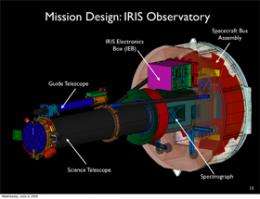MSU scientists to design optics for new solar mission

(PhysOrg.com) -- Montana State University scientists are involved in a new space mission to figure out how energy is transferred through the sun's atmosphere.
As a partner on the IRIS team headed by Lockheed Martin, MSU will receive about $3 million to design an optical system for a telescope that could be launched on a NASA rocket in 2012, said solar physicist Charles Kankelborg. If Lockheed Martin agrees, MSU could receive another $2 million for an associated project involving MSU students.
"It is really exciting," Kankelborg said.
IRIS, short for Interface Region Imaging Spectrograph, was one of two missions that recently won NASA's Small Explorer Competition. The other was GEMS, or Gravity and Extreme Magnetism Small Explorer. When NASA announced the winners in June, it gave the go-ahead for development teams to turn IRIS and GEMS into complete missions for up to $105 million each.
The IRIS team will design its telescope to face the sun at all times, orbit the Earth at least three years and gather images from the sun's chromosphere and transition region, Kankelborg said. The sun's transition region is invisible from the ground. During a total eclipse of the sun, the chromosphere is seen as a thin red layer of atmosphere just above the bright yellow photosphere.
Dave Klumpar, director of MSU's Space Science and Engineering Laboratory, said the MSU student project, if allowed to continue, would ride on the same spacecraft as MSU's optical system. Instead of facing the sun, however, it would face away from the sun and gather information from the dust particles that scatter sunlight in space. Called the Gegenschein Imager, the instrument would be built largely by MSU undergraduates with oversight by Klumpar and Larry Springer, senior engineer and project manager for SSEL, formerly of Lockheed Martin.
"By looking at that reflected light coming off these little dust particles, we can learn a lot about how that dust gets generated, how it behaves, how it moves around, what the sources are and how it finally dissipates and if there are variations in dust distribution in time or space," Klumpar said.
The Gegenschein Imager would be about the size of a shoe box. It would include, among other things, a digital camera, electronic control box and passive shield against light and radiation, Klumpar said. He added that the project would be a "perfect opportunity for students to apply their skills, the knowledge that they get in the classroom and bring it into a real life design fabrication and operation effort that involves students from a wide variety of disciplines."
IRIS is the latest in a string of solar missions involving MSU scientists. TRACE, or Transition Region and Coronal Explorer, was the one that drew Kankelborg to MSU in 1996. The same scientist who headed that mission -- Alan Title from Lockheed Martin -- is heading the IRIS mission.
Kankelborg said Lockheed Martin scientists approached him two years ago to see if he might be interested in joining the IRIS team. After signing on, Kankelborg helped develop the concept for the mission. Nathan Pust, a postdoctoral researcher at MSU, built and tested a prototype of the optical system that would ride on IRIS.
Provided by Montana State University (news : web)

















